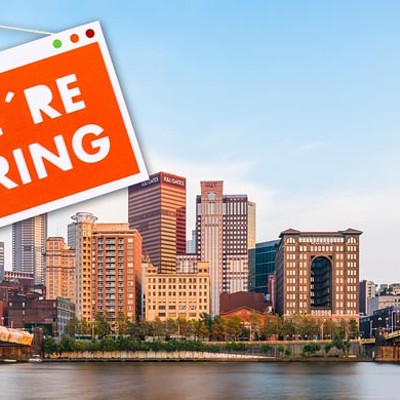It's true that this squat, metal "bridge" was never built to carry traffic. But it isn't going anywhere either.
Built in 1922, the Greenfield Bridge was a graceful, if perhaps overly ornamented structure, as befit its status as an approach to Schenley Park. But the ensuing years were not kind to the span (whose formal name, incidentally, is the Beechwood Boulevard Bridge). By the 1970s, the bridge was badly worn out. Chunks of concrete were coming loose from the structure, falling to the highway and jeopardizing traffic below. Those concerns prompted a 1980 overhaul, which was less than entirely successful.
Not only did the rehab strip away much of the bridge's charm, but the problems returned. By the 1990s, the bridge had again become an eyesore. Today as before, writes bridge historian Bruce Cridlebaugh on his fine site pghbridges.com, "[T]here are many signs of cracks and leaks all over the main arch and its abutments. ... The abutments are favorite targets for graffiti. What was once a grand statement is now a crumbling wisecrack."
City workers slung nets around the bridge's superstructure, in hopes of catching any debris that might fall. The shrouds gave the bridge an ominously funereal air, and in fact, in early 2003 a motorist alleged that a chunk of concrete came off the bridge and struck her car. City officials contested the claim; the concrete that fell on her car was a different kind of concrete, they insisted. Apparently, there's all kinds of concrete stuff rotting away inside the city limits. As you can probably imagine, this wasn't much consolation, and the driver sued anyway.
Fortunately, the previous year the city had already taken action to protect motorists. In 2002, the city sought bids to build a "temporary protective structure" directly beneath the bridge, stretching the entire width of the Parkway.
That "temporary structure" has been in place for two years now. I've seen marriages that were less permanent.
Installed in the autumn of 2003, the span was supposed to be the first part of a rehabilitation project slated for 2005. The idea was that before and during the rehab, the lower span would protect motorists from the damage and repairs on the upper one.
But those repairs never took place. During the city's 2004 budget cuts, Pittsburgh's budget for maintaining roads and other infrastructure was cut by two-thirds: The funding available for work that year dropped from just over $30 million to a little under $10 million; since the bridge is structurally sound enough to drive across, the Greenfield Bridge project was one of the casualties. (Among the other projects that were cut that year: repairs to the Mount Washington scenic overlooks and the fire-scorched nature center in Frick Park, which was damaged by fire in the summer of 2002. Bids to repair the overlooks are only now being sought; the nature center remains shuttered.)
But the "temporary" structure is at least an improvement over the old system, in which nets alone protected motorists. "When the net gets too many holes, the city replaces the nets instead of repairing the structure," wrote Joe Grata, the Post-Gazette's justifiably irritable transportation writer, in 1999. In that piece, Grata shared readers' befuddlement "that Pittsburgh found money to build two stadiums but can't find money to fix the Greenfield Bridge."
Of course, the problem is that Pittsburgh didn't have to find money for the stadiums on its own: It was able to tap state and regional tax dollars to get them built. By contrast, while the highway below the bridge is maintained by PennDOT, the Greenfield Bridge above it is city-owned and operated. So unless you good citizens of Murrysville want to send your poor relatives in Pittsburgh a few bucks, you should learn to appreciate that "bridge to nowhere." It's there so our crumbling infrastructure doesn't become your problem ... literally and figuratively taking a load off your mind.
Of course, it might not hurt for you to practice ducking.










